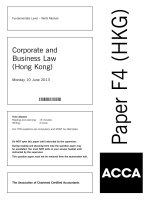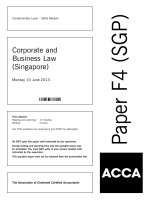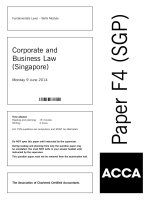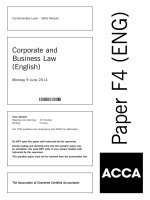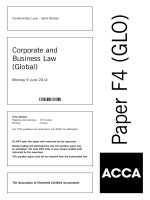ACCA f4 corporate and business law vietnam 2012 dec a
Bạn đang xem bản rút gọn của tài liệu. Xem và tải ngay bản đầy đủ của tài liệu tại đây (78.8 KB, 10 trang )
Answers
Fundamentals Level – Skills Module, Paper F4 (VNM)
Corporate and Business Law (Vietnam)
1
December 2012 Answers
The question tested the candidates’ knowledge of the duties and powers of the Standing Committee of the National Assembly, and
the factors that limit the powers of the National Assembly.
(a)
The Standing Committee is the permanent standing body of the National Assembly.
The duties and powers of the Standing Committee of the National Assembly are defined in Article 91 of the Constitution.
The Committee presides over the election of members of the National Assembly, and deals with administrative arrangements
for the sessions of the National Assembly, including the preparation, convening of meetings and chairmanship.
The Committee has a duty, delegated by the National Assembly, to explain the Constitution, laws and ordinances, issue
decrees and supervise the implementation of legislation. It also supervises the activities of the government and the judiciary.
If the decisions of government are incompatible with the Constitution, the Committee may submit proposals to the National
Assembly to amend these.
The Committee has a role in monitoring and supervising the decisions of People’s Councils. It may provide guidance to these
bodies and can repeal improper resolutions. If deemed necessary, the Committee may dissolve People’s Councils if their
actions or inactions are considered to be damaging to the public interest.
The Committee directs, harmonises and coordinates the activities of the Council of Ethnic Nationalities and the committees
of the National Assembly.
If the National Assembly is not convened, the Committee may declare war, subject to a requirement to report on this to the
National Assembly at the earliest opportunity. It can declare a total or partial mobilisation, and proclaim a national or local
emergency.
The Committee may conduct external relations on behalf of the National Assembly.
Subject to a decision of the National Assembly, the Committee may hold a popular referendum.
(b)
There are two factors that limit the powers of the National Assembly.
Firstly, the National Assembly cannot take any action that is inconsistent with the provisions of the Constitution. This is
confirmed in Article 146 of the Constitution, which states that the Constitution is the ‘fundamental law of the State and has
supreme legal force’.
Secondly, the National Assembly must not act in a manner that contravenes the provisions of international treaties to which
the State has committed itself. However, Article 84 of the Constitution empowers the National Assembly to nullify international
treaties if appropriate.
2
The question asked candidates to explain the essential characteristics of a legally binding contract, and to define the terms ‘bilateral
contract’, ‘unilateral contract’ and ‘ancillary contract’.
(a)
The law relating to contracts is set out in s.7 of the Civil Code.
Article 388 defines a civil contract as an agreement between parties in relation to the establishment, modification or
termination of civil rights and obligations. As this definition specifies that agreement between parties is required, it follows
that one party must propose an offer and another must accept the offer.
Article 390 defines an offer as a clear expression of an intention to enter into a contract and to be bound by such offer made
to another specific party. ‘Clear expression’ suggests that the offer must be specific and not vague. The proposal must indicate
that the person making it is prepared to be legally bound.
‘Another specific party’ means that the counterparty must be identifiable, though not necessarily at the time the offer is made.
The counterparty may be one or more persons, but a general offer made to the whole world cannot be regarded as an offer.
Therefore, advertisements, tariffs and goods on display do not constitute offers as such, but rather an invitation to make offers.
The offer may include a time-limit, but this is not essential for it to be capable of acceptance.
The offer must be communicated in order for it to be considered by the counterparty. Article 391(2) specifies that this may
be by delivery, placing it in an information system or any other means through which the counterparty comes to know about
it.
Article 404 states that a contract is entered into when the offeror receives a reply accepting the offer. In some cases, silence
may be regarded as acceptance, if this is anticipated by both parties.
(b)
(i)
Bilateral contract:
Article 406(1) defines a bilateral contract as one in which each party has an obligation to the other.
The bilateral contract is the most common type of contract in daily business life. It is brought about between two known
parties who agree the rights and obligations that shall ensue.
7
For example, when a seller enters into a contract with a buyer, the seller agrees to transfer ownership of goods or services
to the buyer, and in turn the buyer agrees to pay the price.
(ii)
Unilateral contract:
Article 406(2) defines a unilateral contract as one in which only one party has an obligation to the other.
The most common example of a unilateral contract is where one party offers a reward for carrying out a certain act.
Therefore, if an individual loses a valuable necklace and offers a reward for the return of the necklace, by giving notice
of the reward that individual incurs an obligation. The offer is not made to a known party, but it is addressed to any
specific person who finds the necklace and returns it. As no return promise has been made, nobody is obliged to look
for or find the necklace. The offeror alone incurs an obligation, and only then if the necklace is found and returned.
(iii) Ancillary contract:
Article 406(4) defines an ancillary contract as one whose effectiveness depends on the outcome of another contract.
There are several practical examples of ancillary contracts.
An ancillary contract may be entered into to keep an offer open for a specific period of time. Here there are two contracts
but they are linked to one another. The primary contract is that which sets out the main rights and obligations and the
second is that which commits the offeror not to terminate the offer.
A more common type of ancillary contract is a personal guarantee given to support a debtor’s obligation. The guarantor
undertakes to pay the obligation if the debtor fails to do so.
3
The question asked candidates to define ‘redundancy’ (or ‘retrenchment’), and to explain the provisions of the Labour Code in
relation to redundancy.
The provisions relevant to both parts of the question are set out in Article 17 of the Labour Code.
Redundancy, or retrenchment, occurs when an employer dismisses workers due to structural or technological changes that lead to
certain jobs no longer existing, or continuing to exist in a radically different form.
Structural change alludes to changes in the organisation in relation to work processes or distribution. For example, a company may
decide to close physical retail outlets in favour of using call centres or the internet. An organisation may also have to change the
basic content of certain jobs, such as reducing the focus on administration and increasing the sales and marketing element
attached to the position.
Technological changes are the most common reason for redundancy. Technology often enables manual processes to be replaced
by automated processes, which means that organisations can downsize (reduce the overall number of employees) or delayer
(remove a whole level of management).
Article 17 of the Labour Code provides protection for workers with service of one or more years in the event of redundancy. These
employees should be retrained for alternative jobs within the organisation. If no alternative positions can be offered and dismissal
is unavoidable, the employer must pay a loss of employment allowance at the rate of one month’s salary per full year of
employment, subject to a minimum of two months’ wage. For employers who were qualified to participate in the job loss insurance
scheme, the loss of employment allowance was paid by the employer up to 31 December 2008. Since 1 January 2009, the job
loss insurance allowance has been paid out from the insurance fund under the provisions of the Law on Social Insurance.
If redundancy applies to a number of employees, the employer must prepare a list of those to be dismissed. In deciding on the
employees to be dismissed, the employer must, in the context of business requirements, pay due regard to length of service,
qualifications, family circumstances and factors concerning each individual worker.
Having finalised the list of workers affected, the employer may proceed to retrench after consultation with the executive committee
of the trade union, and then only after notifying the local labour office. Article 38 of the Labour Code sets down certain rights in
favour of the trade union in the event of disagreement on the terms of the retrenchment. This may result in the matter having to
be settled as a labour dispute.
When making employees redundant, payments due to those affected must be made in a timely manner. For this purpose,
Article 17(3) insists that the employer must maintain a reserve fund for loss of employment allowance.
Article 17(4) imposes obligations on the government to assist those affected by redundancy. In order to help former employees find
new work or become self-employed, the government must adopt policies and measures to provide for training and retraining,
provide production and business guidance, including low interest rate loans from the National Employment Fund, and provide
financial assistance to localities and branches that have high unemployment levels due to structural or technological change.
8
4
The question sought to test the candidates’ knowledge of the procedures necessary to form a limited liability company, and the
provisions of the Law on Enterprises in respect of the proposed name of a new limited liability company.
(a)
The procedures necessary to form a limited liability company are set out in Articles 13–18 of the Law on Enterprises. The
requirements in Articles 13–16 are generic to all enterprises.
Prior to the formal application for registration, those intending to form the company must agree on who will be involved in
the establishment of the company, the name, registered address and principal business lines of the company, the content of
the constitutional documents and the proposed capital structure. The founders may choose to nominate a legal representative.
The main provisions specifically relevant to limited liability companies are contained in Article 18.
The application for registration is submitted using a standard business form issued by the registration authority. This must be
submitted along with the Charter of the company and a list of members.
The list of members must be supplemented with full personal or corporate details of the initial investors as follows:
(i)
Individual members must provide a copy of their identity cards, passports or other legal identification.
(ii)
Domestic legal entities must provide a copy of the establishment decision and the business registration certificate or its
equivalent.
(iii) The legal representative of the organisation must provide a power of attorney and identity card, passport or other
identification.
(iv) Foreign legal entities must submit a copy of their business registration certificate, certified by the body at which the
registration was made, no later than three months before the date of submission of the business registration documents.
Some companies must have statutory capital in place prior to registration. In such cases, the application must be supported
by the document of an authorised body or organisation certifying the legal capital.
If the lines of business to be carried out require the general director or director to have a practising certificate, this must be
certified as being valid and in place.
On submission of these documents, the registration authority peruses the information provided to ensure it is compliant with
registration requirements. If this is the case, a registration document is issued within 15 days of submission. If the business
line is conditional or the project is subject to evaluation, the time frame for the issuance of the registration document is longer.
(b)
The legal requirements in respect of the name of a limited liability company, and indeed any new business enterprise, are
laid down in Articles 31–34 of the Law on Enterprises.
Article 31 states that the business name must be written in the Vietnamese language but can include numbers and signs. It
must be pronounceable and must allude to the type of enterprise and its proper name.
Article 32–34 of the Law on Enterprises stipulate certain restrictions on names of business enterprises. The business
registration body can reject the proposed name of the enterprise if it does not comply with these restrictions.
A name that is already on the register cannot be adopted, so the name of any new company must be unique. An identical
name is one that is the same in every respect as an existing business name. This applies if the pronunciation of the two
names are the same, even if the characters are different, and where the only difference between two similar names is the use
of ‘&’ and ‘and’. An abbreviated or foreign name that is the same as another company’s abbreviated or foreign name is
considered to be identical.
If the only difference between the name of the new company and an existing company is a number after the name, this is
deemed to be a name that will cause confusion. Similarly, if the word ‘tan’ preceding the proper name or the word ‘moi’
immediately following the proper name is the only difference between the registered enterprise and the new company, this is
also regarded as a name that will cause confusion. This also applies if the only difference is a word such as ‘north’, ‘south’,
‘east’, ‘west’ or ‘central part’.
Names associated with state bodies, the armed forces, political organisations, socio-political organisations and occupational
socio-political organisations cannot be used as the whole or part of the name.
Words and phrases that offend national historical traditions, culture, ethics and fine customs are also prohibited.
Article 33 permits the organisation to use a translation of the Vietnamese name in a foreign language, and the company is
entitled to use both the Vietnamese name and the foreign name. These may also be abbreviated. However, when used in
official documents, the Vietnamese name must be given greater prominence by being printed or written in a larger size.
9
5
The question asked candidates to explain the classes of shares that may be issued by a shareholding company, and to explain their
characteristics.
Article 78 of the Law on Enterprises sets out the classes of shares that may be issued by a shareholding company.
Article 78(1) states that all shareholding companies must have ordinary shares. Article 78(2) permits, but does not oblige,
shareholding companies to issue preference shares. The different types of preference share that may be issued are voting preference
shares, dividend preference shares, redeemable preference shares and other preference shares as stipulated in the Charter of the
company.
Only organisations authorised by the government and the company founders may hold voting preference shares. The voting
preferences are only valid for three years after the issue of the business registration certificate. These shares are then converted
into ordinary shares.
Persons entitled to subscribe for other types of preference share are determined by the provisions of the Charter of the company.
Shares of each generic class must carry equal rights and obligations.
Article 78(6) forbids ordinary shares from being converted into preference shares. However, preference shares may be converted
to ordinary shares, subject to agreement of the general meeting of shareholders.
Ordinary shareholders have four sets of rights:
They are entitled to a dividend, if declared. The dividend must be paid from net profits and is subject to limitations set out in Article
93.
They are entitled to receive notices of general meetings, and to attend and vote at general meetings. Subject to minimum
thresholds, they are entitled to propose business to be heard at a general meeting and to convene general meetings.
They are entitled to receive the financial statements of the company and all formal notices issued to shareholders.
They are entitled to have their capital returned on dissolution of the company, but only after the prior claims of others have been
met in full.
Ordinary shareholders are obliged to contribute the capital due on the share for which they have subscribed.
Preference shareholders have the same rights as ordinary shareholders, except for the limitations set out in Articles 81–83 of the
Law on Enterprises. These limitations are as follows:
Voting preference shareholders may vote on matters at general meetings according to the number of votes set down in the share
certificate. However, they may not assign their shares to other persons.
Dividend preference shareholders have the right to dividends as stated in the share certificate. On liquidation of the company, they
have the right to receive part of the remaining assets in proportion to the number of shares held after the company has paid sums
due to creditors and redeemable preference shareholders. Dividend preference shareholders have no right to vote, attend general
meetings or nominate persons for positions on the board of management or the inspection committee.
Redeemable preference shareholders also have no right to vote, attend board meetings or nominate persons for positions on the
board of management or the inspection committee.
6
The question tested the candidates’ knowledge of the composition of the committee for management and liquidation of assets, and
to explain the duties, powers and responsibilities of the committee.
(a)
The legal provisions governing the composition of the committee for management and liquidation of assets are set out in
Article 9(2) of the Law on Bankruptcy.
The committee must comprise:
(i)
An enforcement officer of the judgement enforcement office.
(ii)
An officer of the court.
(iii) A representative of the creditors of the company.
(iv) A legal representative of the insolvent organisation.
(v)
(b)
Subject to a decision of the judge responsible for the case, a representative of the trade union, a representative of
employees and representatives of expert institutions.
The duties, powers and responsibilities of the committee for management and liquidation of assets are set out in Article 10
of the Law on Bankruptcy.
The committee for management and liquidation of assets is accountable to the court, which in turn must ensure that the
obligations of the insolvent company can be distributed in a proper manner and with minimal losses to all parties involved.
The committee supervises and inspects the use of assets. If appropriate, the committee may propose that the court grants
temporary emergency measures to preserve the assets.
10
The committee must prepare a list of all current assets of the enterprise, a list of creditors and the amounts payable to them
and a list of debtors and the amounts receivable from them, in order to estimate its net worth. From this information, the
committee can recover and manage the assets, data, accounting books and seal of the enterprise.
The order of priority for the distribution of the assets of the enterprise is set down in Article 37 of the Law on Bankruptcy. The
committee must prepare and implement a plan for this purpose.
The committee may also take decisions on the recovery of assets that have already been distributed unlawfully through unfair
preferences (as defined in Article 43) prior to liquidation. For example, the directors may have decided to minimise their
personal losses by redeeming a loan that they have supported by giving their personal guarantees. The committee may pursue
recovery of these payments.
Pursuant to a decision of the judge in respect of the auction of assets, the committee is responsible for implementing the
auction consistent with the procedures laid down in the Law on Auctions. Funds received from the auction must be deposited
by the committee in a bank account.
The committee is also responsible for enforcing any other decisions of the judge presiding over the liquidation.
7
The question sought to test the candidates’ knowledge of the meaning and scope of corporate governance, and why corporate
governance is especially important to companies whose securities are listed on a recognised capital market.
(a)
There is no universally accepted definition of corporate governance. However, several sources provide definitions that capture
the nature of corporate governance and indicate its scope.
One definition of corporate governance is ‘the process of supervision and control intended to ensure that the company’s
management acts in accordance with the interests of shareholders’.
Alternative definitions are:
‘... the sum of those activities that make up the internal regulation of the business in compliance with the obligations placed
on the firm by legislation, ownership, and control. It incorporates the trusteeship of assets, their management and their
deployment.’
‘The system by which companies are directed and controlled.’
Vietnam’s regulations provide a definition that bears similarly to all of the above. They define corporate governance as ‘a set
of rules to ensure listed companies are directed and supervised effectively for the benefits of all shareholders and related
parties’. (Article 2, Regulations on corporate governance applicable to companies listed on the Stock Exchange/Securities
Exchange Centre, issued in conjunction with Decision 12/2007/QD-BTC of the Ministry of Finance dated 13 March 2007.)
(b)
The scope of corporate governance includes the obligations of the company to shareholders, obligations to stakeholders,
responsibilities for direction and management, and transparency.
Shareholders:
A company should uphold and protect shareholders’ rights, and enable shareholders to exercise their rights. This may involve
not only communication of rights and responding to the shareholders’ demands, but pro-actively encouraging shareholders to
enter into dialogue with the company.
Shareholders should be treated equally, whilst acknowledging the diverse interests of different shareholder groups.
Stakeholders:
A stakeholder is any person or entity that is affected by the organisation and can affect the organisation. The main
stakeholders in any organisation are customers, employees, creditors, suppliers, government and the community in which the
company is located.
It is generally accepted that the fiduciary responsibilities of a company extend beyond maximising shareholder value, and that
it is accountable to broader groups in society. The company must also be mindful that stakeholder claims often conflict, and
that it is never possible to satisfy all stakeholder claims simultaneously.
Direction and management:
Companies should be led by an effective board, comprising the necessary technical knowledge, skills and experience to
achieve the objectives of the business in the medium to long term. The leaders of the business must formulate plans in the
context of a changing external environment with a view to minimising risks.
Transparency:
Companies should adopt a transparent approach in their business dealings, making appropriate disclosures in order to close
the ‘knowledge gap’ that exists between those who manage the business and those who own it and govern it.
(c)
Although corporate governance is relevant to most types of business organisation, it is generally acknowledged that it is of
special importance to shareholding companies whose securities are traded openly. There are several reasons for this.
11
In nearly all shareholding companies, there is an ‘agency problem’. Those entrusted with management and direction of the
enterprise represent the interests of many individuals and groups with whom they will rarely, if ever, interact directly. This is
less applicable to organisations such as limited liability companies, in which the members have a more direct managerial
role.
Shareholder wealth is reflected in the share price of companies. Failings in corporate governance can have a direct impact on
the wealth of investors, especially when control failings result in share values falling drastically in short periods of time.
Generally, shareholding companies are larger than other business entities, so their activities have a greater economic impact
and affect more groups of stakeholders.
Shareholding companies rely on high standards to maintain their reputation, thereby reinforcing investor confidence, and
confidence in capital markets generally.
The consequences of failure of quoted companies can be potentially devastating to customers, employees, suppliers and
creditors.
Failures in corporate governance can affect the international standing of an economy, resulting in loss of confidence of
potential overseas investors.
8
The question tested the candidates’ ability to apply their knowledge of non-contractual obligations to a scenario in which a general
director damaged a fruit and vegetable stall in a car accident.
The law relating to non-contractual obligations is set out in Articles 604–605 of the Civil Code.
Article 604(1) states that a person who intentionally or unintentionally causes harm to the life, health, honour, dignity, reputation,
property or other legal rights or interests of another must compensate the injured party.
Bao caused damage to Khanh’s fruit and vegetable stall, ostensibly by driving too fast on a wet road. In doing so, Khanh’s goods
were destroyed, and a liability has therefore been created. That the damage was unintentional is irrelevant, as Article 604(1)
provides for compensation whether there was intent or not.
Article 604(2) states that the person causing the damage must pay compensation, even if the person was not at fault.
Article 605(2) limits the size of the compensation payable if the damage was unintentional and the value of compensation is large
in relation to the circumstances of the person causing the damage.
Article 605(1) requires damage to be compensated in full and in a timely manner. The form of the compensation may be agreed
between the parties, whether in money or in kind.
Applying these provisions to the scenario, Bao has admitted liability, although he subsequently suggested that his statement of
liability was made while in a state of shock. The mere fact that Bao’s car left the road and caused the damage is sufficient to satisfy
the provisions of Articles 604(1) and 604(2).
As payment of some compensation is inevitable, the primary obligation lies with Tradeco, and not Bao personally. Bao was driving
to a business meeting in a company car, so the damage was caused in the course of Bao’s normal work. Tradeco is therefore
vicariously liable for the non-contractual obligation of Bao.
In turn, Tradeco may choose to take a regress action against Bao for the compensation that it has to pay to Khanh. As the general
director of Tradeco, Bao is unlikely to be able to rely on Article 605(2) to reduce his obligation to the company.
The size of the compensation could be a matter of contention between the parties. If the matter was presented to a court, the
compensation payable would be the actual losses incurred (the destroyed inventory), plus any missed profits suffered by the
claimant (loss of business caused by having to order new inventory). In practice, however, this would probably be a matter for the
insurance company.
A final consideration is the potential criminal liability that could arise from Bao driving too fast, but this would depend on the
evidence available to the authorities in investigating the accident.
9
The question asked candidates to consider the advantages and disadvantages of the alternative corporate forms that could be
adopted by a film producer working in collaboration with an investor.
Lan is a successful film director whose usual financial supporters are reluctant to assist with a production that they consider to be
too radically different to Lan’s usual output. Nhu has come forward as a potential financial backer and has expressed several needs.
Nhu is prepared to give a definite financial commitment, but is not prepared to make this open-ended. If possible, she wishes to
limit her exposure to risk. She has indicated that any future collaboration will be occasional but not regular, and is looking to adopt
a simple corporate form that is not time consuming. As a prospective investor, she does not want to get involved in the production
itself.
From the needs expressed by Nhu, operating under a contractual arrangement with both her and Lan acting as an individual
entrepreneur should be ruled out, as this would expose both of them to unlimited liability. For the same reason, they should rule
out forming an unlimited partnership. Although both business forms are simple and would not be time consuming in respect of
management or administration, they are inappropriate for the specific requirements of Lan and Nhu.
12
Nhu can be confident that her liability will be limited to the size of her investment if she forms either a limited liability company
or a shareholding company with Lan. Both types of company enable the founders to ring-fence any investment, with the company
thus formed having a separate legal personality. They could form their company and retain absolute control as the only two
shareholders.
However, a shareholding company is clearly unsuitable for this type of business, as the parties concerned would have a maximum
of one project at a time and then only work together occasionally in the future. The shareholding company also fails to address the
need for a simple business form.
A limited liability company would be the more suitable of these two options, as there are fewer formal requirements in relation to
management and operating structure imposed in chapter III of the Law on Enterprises.
Lan and Nhu could consider forming a limited liability partnership, with Nhu as an investing partner. This is a relatively uncommon
business form in Vietnam, but its characteristics match the requirements of the participants extremely well. Article 140(2) permits
a limited partner to invest and be exposed only to the extent of the investment. It also states that the investing partner shall not
participate in the management and operation of the enterprise, which is consistent with Nhu’s expectations. Most important, the
partnership is a very simple business form that can fulfil the business requirements while operating under a Partnership Council
(comprising Lan and Nhu) who can meet as often or as irregularly as deemed to be necessary for their purposes.
In conclusion, Lan and Nhu should consider setting up either a limited liability company, or a partnership in which Nhu has limited
liability.
10 The question tested the candidates’ ability to apply their understanding of the rights of shareholders to constrain the actions of the
board of management of a shareholding company. It also asked candidates to examine the potential consequences to the members
of the board of management when acting outside the constraints imposed by the Charter of the company.
(a)
All shareholding companies must have a Charter, which sets out the basic characteristics of the business, as well as making
provisions for capital, ownership and membership rights and obligations. Article 21(3) states that this must include the lines
of business of the company.
Article 9(1) of the Law on Enterprises obliges business organisations to conduct business strictly in accordance with the lines
of business as set out in the business registration certificate, which in turn will mirror the content of the Charter.
It should be possible for those purchasing shares in the company to rely on the Charter as a clear indication of the purposes
and activities of the company. As shares represent permanent capital, shareholders are effectively ‘locked in’ to their
investments, so if the board takes actions that are not consistent with the company’s main aims, these investors have to rely
on the protection afforded by legislation.
As the board of management of Drink Company has taken steps to diversify into the fitness centre business, this confirms
that the board has acted outside its powers. The fact that the proposed fitness centres will include an area set aside for coffee
shops is somewhat peripheral to the main purpose of the centres. It would have been prudent for the board of management
to have at least consulted the general meeting of shareholders before pursuing its new plans. The general meeting could then
have sanctioned any changes necessary to the Charter to facilitate the diversification, if indeed they agreed that it should go
ahead at all.
When a company enters into a contract that falls outside the terms of reference set out in the Charter, the shareholders can
apply to the court to render the transaction null and void. In the case study, this would only be possible if the contracts for
the purchase of the buildings and equipment, and for the expenditure on additional marketing, had not already been
concluded with third parties.
The shareholders are also unable to contest the dividend recommended by the board of directors.
Notwithstanding these limitations, the shareholders can take various actions. Article 79 states that provided those objecting
to the new initiative collectively hold 10% or more of the shares of the company, they could call a general meeting for the
purpose of discussing the proposed initiative and agreeing a new way forward. The shareholders could also agree to sell any
premises or equipment that had been acquired.
(b)
Article 108 states that when implementing its functions and performing its duties, the board of management shall strictly
comply with the provisions of law, the Charter of the company and resolutions of the general meeting of shareholders. As the
board of management has already taken steps to diversify into the fitness club business, they are already in breach of the
provisions of the Charter.
The same Article goes on to state that when the directors pass a resolution that is contrary to the law or the Charter of the
company, and as a result there is damage to the company, the members of the board who agreed to pass the resolution shall
be jointly and severally liable and must compensate the company. Any director who opposed the resolution is exempt from
liability.
The damage to the company could be financial losses, but may also take the form of moral harm through damage to the
reputation of the company.
If sufficiently dissatisfied with the actions of the board of management, the shareholders could also propose that some or even
all of the members of the board of management be dismissed. They could then nominate alternative persons to serve on the
board.
13
Fundamentals Level – Skills Module, Paper F4 (VNM)
Corporate and Business Law (Vietnam)
1
2
December 2012 Marking Scheme
(a)
Per power/duty of the Standing Committee
1 mark
(8 marks)
(b)
Limitations imposed by Constitution
Limitations imposed by international treaties
1 mark
1 mark
(2 marks)
(Total 10 marks)
(a)
Offer and acceptance required
Specific persons
Clear intent to form a legally binding relationship
Communication
Acceptance required
Acceptance of all terms
1 mark
1 mark
1 mark
1 mark
1 mark
1 mark
(maximum 4 marks)
(b)
(i)
Definition of bilateral contract
Up to 2 marks
(ii)
Definition of unilateral contract
Up to 2 marks
(iii) Definition of ancillary contract
Up to 2 marks
(6 marks)
(Total 10 marks)
3
Definition of redundancy
Specific reference to structural and technological change
Obligation to offer alternative employment
Need to compile a list of those affected
Factors that must be considered when deciding on those affected
Role of trade union
Possibility of labour dispute
Obligations of government
1 mark
1 mark
1 mark
1 mark
Up to 2 marks
1 mark
1 mark
Up to 2 marks
(Total 10 marks)
4
(a)
Agreement on members and basic characteristics of company
Mandatory documents – Charter, standard form
Particulars of founders
Legal representative
Capital and licensing requirements
Matters specific to one member company
1 mark
1 mark
1 mark
1 mark
1 mark
1 mark
(maximum 5 marks)
(b)
Company must have Vietnamese name and may have foreign name
Each restriction on names
1 mark
1 mark, maximum 4 marks
(5 marks)
(Total 10 marks)
5
Characteristics of ordinary shares
Voting preference shares
Redeemable preference shares
Dividend preference shares
Up to 4 marks
Up to 2 marks
Up to 2 marks
Up to 2 marks
(Total 10 marks)
15
6
7
(a)
Representative of company
Representative of union/workers
Representative of creditors
Enforcement officer
1 mark
1 mark
1 mark
1 mark
(4 marks)
(b)
Per duty, power or responsibility
1 mark
(maximum 6 marks)
(Total 10 marks)
(a)
Definition of corporate governance
Up to 2 marks
(2 marks)
(b)
Shareholders’ rights and equal treatment
Stakeholders
Direction and management
Transparency
1 mark
1 mark
1 mark
1 mark
(4 marks)
(c)
Size of business and impact of failure on stakeholders
Agency problem
Investor confidence
Confidence and reputation of markets
1 mark
1 mark
1 mark
1 mark
(4 marks)
(Total 10 marks)
8
Nature of non-contractual obligation and application to case
Vicarious liability of Tradeco
Right of regress action
Size and nature of compensation
Possible criminal liability
Up to 4 marks
1 mark
1 mark
Up to 3 marks
1 mark
(Total 10 marks)
9
Discussion and conclusion that individual entrepreneurs unsuitable
Discussion and conclusion that unlimited partnership unsuitable
Discussion and conclusion that shareholding company unsuitable
Discussion of advantages and disadvantages of limited liability company
Discussion of advantages and disadvantages of limited partnership
Reasoned conclusion
1 mark
1 mark
1 mark
Up to 3 marks
Up to 3 marks
1 mark
(Total 10 marks)
10 (a)
(b)
Best interests – provisions of Law on Enterprises
Constraints imposed by law, Charter and shareholders
Obligations of board of management
Joint and several liability
Financial and moral harm
Up to 2 marks
Up to 2 marks
Up to 2 marks
1 mark
1 mark
(maximum 7 marks)
Rights of general meeting to set aside transactions, decide policy
Rights to call meeting, dismiss members of board of management
Up to 2 marks
Up to 2 marks
(maximum 3 marks)
(Total 10 marks)
16

